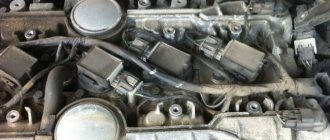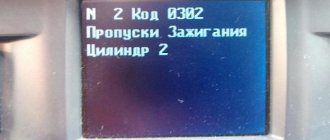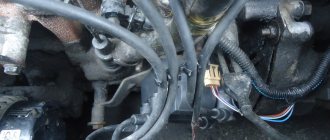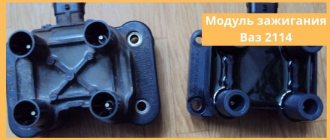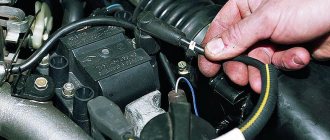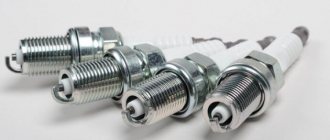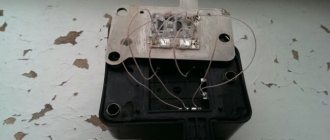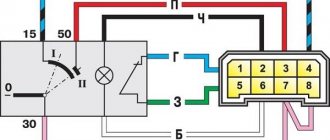Among experienced car owners, there are only a few who have never encountered such a phenomenon as cylinder misfires. In practice, it looks like this: the car starts to twitch, but does not move. As you understand, there is little pleasure in this.
Previously, all engines included four cylinders. When one of them failed, the engine began to fail. That is, the engine worked only on three and four cylinders.
Today there are up to 12 cylinders on passenger cars. At the same time, the phrase “troubles the engine” still remains relevant and has firmly entered into the everyday life of drivers.
Find out which cylinder is not working
First of all, we find out which of the cylinders is not working, this is all done quite simply, one by one we remove the high-voltage wire from the spark plugs, if you remove the wire and the engine starts to work even worse (you can tell by the sound), we put the wire back on. If you removed the high-voltage wire and the engine operation did not change, then something happened to the cylinder data.
Vehicle characteristics
In 2001, the line of the VAZ automobile concern was replenished with the five-door hatchback VAZ 2114. The platform for creating the model was the VAZ 2109. Basically, the car was equipped with 4 cylinder 8 valve engines. The power system consists of an injection mechanism and an electronic control unit.
Engine operation is controlled by special sensors that inform the central module about engine performance. The module processes information and sends an impulse to the devices that need to be activated at the moment:
- prepares the required mixture quality depending on the speed and engine speed;
- distributes the spark among the cylinders in a certain sequence.
During production, the model was equipped with different engines.
| Parameter | Meaning | ||||
| Engine | 2111 | 11183 | 21124 | 21126 | 21114 |
| Configuration | L4 | L4 | L4 | L4 | L4 |
| Volume, l | 1499 cm3 | 1596 cm3 | 1599 cm3 | 1597 cm3 | 1596 cm3 |
| Number of valves per cylinder | 2 | 2 | 4 | 4 | 2 |
| Piston stroke | 71 mm | 75.6 mm | 75.6 mm | 75.6 mm | 75.6 mm |
| Cylinder diameter | 82 mm | 82 mm | 82 mm | 82 mm | 82 mm |
| Compression ratio | 11,5 | 9.6 — 10,0 | 10.3 | 11 | 9,6 |
| Gas distribution mechanism | OHC | OHV | OHV | OHV | OHV |
| Rated power | 77 l. With. at 5400 rpm min. | 82 l. With. at 5300 rpm min. | 89 l. With. at 5 thousand rpm min. | 98 l. With. at 5600 rpm min. | 81.6 l. With. at 5200 rpm min. |
| Max. torque | 116 Nm, at 3 thousand rpm. min. | 125 Nm, at 3 thousand rpm. min. | 131 Nm, at 3700 rpm. min. | 145 Nm at 4 thousand rpm. min. | 125 Nm, at 3000 rpm. min. |
| Supply system | injector | injector | injector | injector | injector |
| Maximum speed, km | 160 | 167 | 172 | 182/175(automatic transmission) | 175 |
| Acceleration time from 0 to 100 km/h, s | 15 | 13,2 | 12,4 | 11,2/13,1 | 12,5 |
| Fuel | AI 93 | AI 95 | AI 95 | AI 95 | AI 95 |
| Claimed gas mileage | 7.6 l/100 km combined cycle | 7.8 l/100 km combined cycle | 7.0 l/100 km combined cycle | 7.2 l/100 km combined cycle | 7.2 l/100 km combined cycle |
Checking spark plugs
We unscrew the spark plugs and inspect their condition. A non-working spark plug will have black carbon deposits on the insulator of the central electrode, or even worse, there will be a crack, I had a crack on two spark plugs, so I changed 4 spark plugs at once, the price was about 500 rubles, just check the spark plugs for cracks right away, right in the store. After replacing the spark plugs my car continued to fail
Common faults
Let us immediately note that the problem with omissions that arise should only be solved at specialized service stations. You can identify the problem cylinder yourself. But after this, you should go to a car service center and, using computer diagnostics and appropriate measures, fix the breakdown.
Diagnostic program
There are several reasons why such a phenomenon as misfires in the ignition system occurs on the VAZ 2114.
- Problem candles. If carbon deposits appear on them, the gap decreases or increases, they will not be able to work properly. As a result, there are misfires in the cylinders. Quite often, spark plugs do not work for the simple reason that the car owner decided to save money and buy spark plugs of dubious quality. You should not count on their long service life and reliable operation.
- Wiring problems. Here you most often have to deal with wire wear, chafing, and mechanical damage. Sometimes the problem is solved by replacing the wiring. But in some cases, wiring can negatively affect the functionality of the devices it goes to. As a result, both the wiring and the device must be replaced.
- Contacts. Contacts may burn out, become covered in oil, or rust. Cleaning them or completely replacing them may help. The second option is preferable in order to reduce the risk of omissions occurring after a short period of time.
- Damage to the ignition coil or module. If you have a VAZ 2114 with a 1.6-liter engine, you are dealing with a coil. Owners of the newer version with a 1.5-liter engine are already solving problems with the ignition module. Regardless of this, units often fail and cause leaks. There is no point in repairing them, so it is better to immediately replace them with new ones.
- Use of low-grade fuel. The problem for many owners of domestic cars is that they, sometimes unknowingly, doom themselves to constant repair work. A trivial example is the use of cheap gas stations. Low-quality gasoline produces a poor air-fuel mixture, clogs filters, and clogs injectors. This often causes misfires in the cylinders. The right solution is to fix the problem and start using good gas stations. Their gasoline is more expensive, but you will spend many times more money on repairs if you don’t stop refueling with God knows what.
- Omissions. They also often occur due to impaired compression in the cylinders. This fault should be checked almost first.
- The gas distribution mechanism is not adjusted correctly. Its adjustment will not take much time; the work can be done with your own hands.
- Excess air enters the fuel system. This may occur due to damage to the intake manifold, wear of the rings on the injectors and other defects. Therefore, you should check the system for leaks and find sources of air intake.
- The gap between the piston and cylinder has decreased. There may be many reasons for this, but you will definitely have to check them if this is the reason.
Compression measurement
Then we measure the compression.
1) Turn off the ignition
2) Remove the spark plug
3) Screw in the compression gauge
4) We are looking for a partner who will start the car
5) We start turning the engine and look at the compression
Warning: under no circumstances allow the end of the high-voltage wire to touch you or the car body when igniting.
The norm for compression is 14 atmospheres. A deviation of 3 atmospheres is permissible, that is, from 11 atmospheres, this will be the norm for cylinders.
Important nuances
If misfires occur on a VAZ 2114, this is a fairly serious problem that can develop into more serious consequences. At first the car jerks, then misfires occur, and full power is not used.
Swimming revs
It will be difficult to start the car, and over and over again the detonation noise of the air-fuel mixture will occur in the idle cylinder.
- Cylinders can be checked using computer diagnostics. This method produces the corresponding errors in the form of codes. Using them it is already easy to determine which cylinder has problems. For example, if there is a misfire in cylinder 2 on a VAZ 2114, then the error code will look like P0302.
- The electronic control unit, that is, the ECU, regularly monitors the operation of the power unit using the appropriate sensors installed on the VAZ 2114. In the case of misfires, the ECU estimates the rotation speed using the crankshaft sensor. If there is a misfire in cylinder 4 on a VAZ 2114, at a certain moment the crankshaft will rotate more slowly, which will be determined by the computer.
- Modern electronics make it possible to automatically turn off a cylinder that has problems. In other words, the fuel supply to it stops.
- The cylinder may return to operation after some time, or after the engine is restarted.
- No more than two cylinders can be switched off at the same time. For your “fourteenth” model, two cylinders are enough to get to the garage or the nearest service station, thereby keeping the catalyst intact.
- In early versions of the VAZ 2114, the electronics generated errors about omissions if the car was moving on bad roads. On updated versions, this problem was eliminated by installing a road surface quality sensor.
- Misfires are not always easy to determine, since this phenomenon is not constant and can occur periodically on the VAZ 2114.
- Car owners often make mistakes in winter, when the engine starts to throttle when warming up, and then, when warmed up, it works normally. This phenomenon occurs due to wear on the cylinders, since when warmed up the metal elements expand and the system returns to normal operation.
- If the VAZ 2114 engine runs normally at idle, but when the load increases, it starts to stall or operate unstably, the cause should be sought in a burnt gasket. Because of this, pressure increases inside the combustion chamber and a leak occurs.
- When the engine coughs a little, but soon returns to normal operation, it becomes difficult to determine the cause. This will require a full diagnosis.
Article on the topic: Malfunction of the idle speed control VAZ 2114
Let's figure out how to set the ignition on a VAZ 2114 correctly
The first cars in this series were produced with a contactless ignition system, and an electronic one appeared only later. Due to the fact that throughout its history the car has been equipped in different ways, before setting the ignition on the VAZ 2114, you need to find out what it is.
Ignition systems of the 8-valve injection VAZ-2114
You can determine the type of ignition by looking under the hood:
- If you find a switch near the “heart” of your car (analogous to a distributor installed on contact systems), it means that your car belongs to the first series, and the ignition of the VAZ 2114 injector on it is non-contact, based on the switch-distributor block. The ignition in such systems is adjusted by gradually turning the distributor, and the results of the work depend on the experience of the performer and the availability of special equipment. Then, using a strobe light, you can debug the system exactly as the car owner wants.
- If this part is missing, your car belongs to the tenth family and is equipped with an electronic ignition system. It cannot be installed manually and its operation is completely controlled by the ECU. However, it is not completely unregulated, because by connecting to the on-board computer, some of its parameters can be reconfigured to your liking, but only a few specialists know how to do this correctly.
Diagnostics
To accurately detect misfires on cylinders 1 and 4 of the VAZ 2114, it is necessary to perform computer diagnostics. It is carried out using a special electronic module connected to the diagnostic connector. After starting the scan, the computer will automatically produce results in the form of special codes corresponding to certain errors.
So, for misfires there are codes:
In this case, the last digit in the code corresponds to the number of the faulty cylinder. For example, misfire in cylinder 1 of a VAZ 2114 will be designated as P0301 and so on...
Occurrence of misfires
Misfires themselves are common to all four-stroke engines, from the oldest to the most modern. About this, most often they occur on any one cylinder, as a result of which only 3 cylinders remain in operation.
This phenomenon, well known to many drivers, is called “triple movement”. At the same time, the motor operates unevenly, with frequent jerks, and the overall power drops by more than a quarter. In addition to problems on one cylinder, misfires also occur in cylinders 1 and 4 of the VAZ 2114. This situation is much more critical and requires an urgent solution.
If you notice misfires on your car, you should stop driving it as soon as possible and carry out repair work. It is impossible to continue operating such a vehicle without troubleshooting, since initial problems with starting can develop into constant jerking caused by fuel detonation, and even engine failure.
Speaking about omissions, it is important to note that sometimes car enthusiasts mistake completely different malfunctions for ignition system problems, namely:
- slight tripping of the car after starting in the cold season. It is caused not by ignition errors, but by cylinder wear. After starting, the cold elements of the engine begin to heat up and, as a result, expand. These changes in size cause “tweaking”;
- car tripping when suddenly adding gas at idle. This phenomenon is also caused not by poor ignition, but by damage to the cylinder head gasket, through which a leak occurs;
- engine tripping due to poor fuel.

